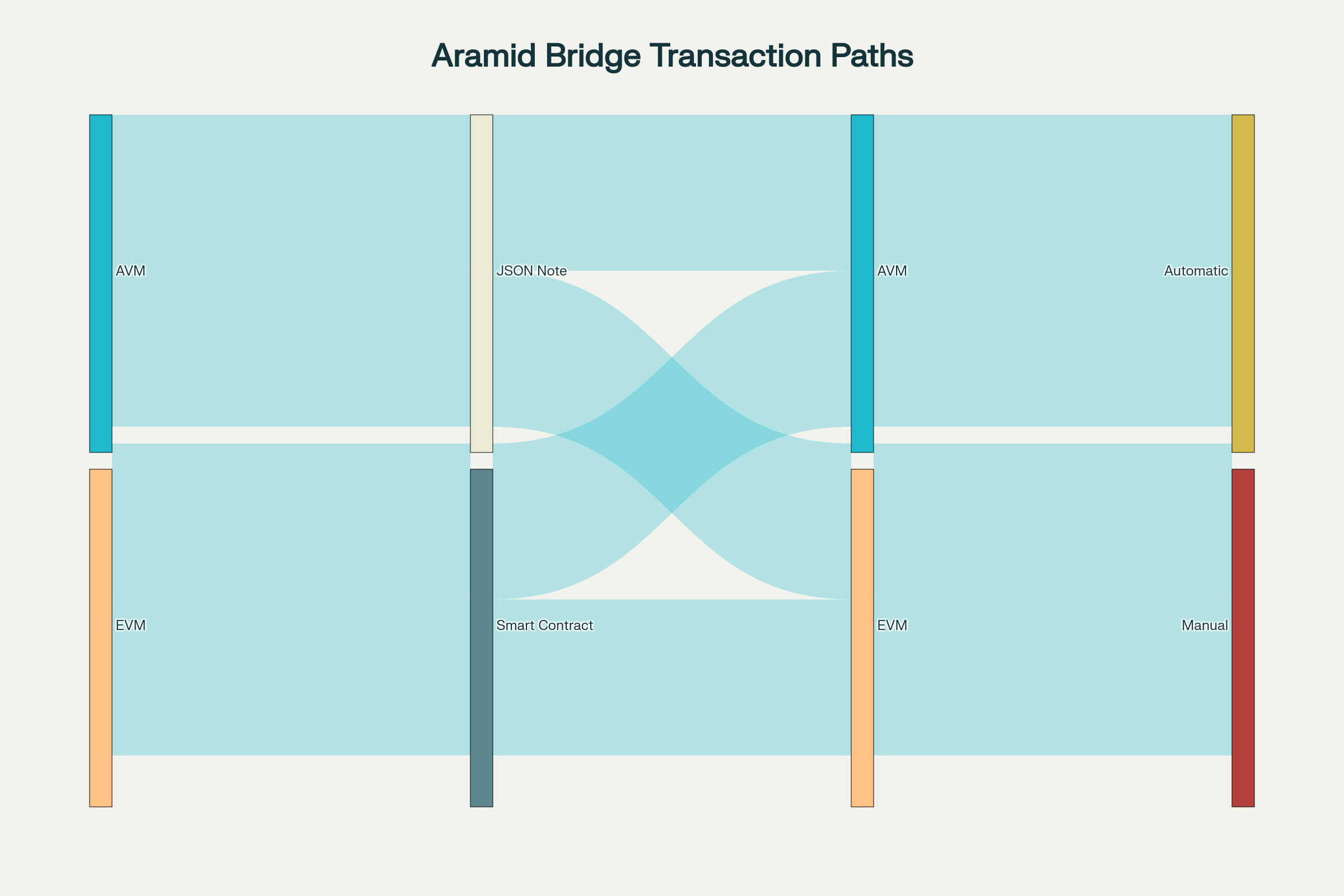Arbitrage & Claim
This guide provides practical, example-driven instructions for all four core arbitrage transaction paths supported by Aramid Bridge. Each section includes a real or representative transaction example and clear steps for asset claiming.
Supported Arbitrage Networks
| Network | Consensus | Chain ID | Symbol | Bridge Address |
|---|---|---|---|---|
| Voi | AVM | 416101 | VOI | ARAMIDFJYV2TOFB5MRNZJIXBSAVZCVAUDAPFGKR5PNX4MTILGAZABBTXQQ |
| Algorand | AVM | 416001 | ALGO | ARAMIDFJYV2TOFB5MRNZJIXBSAVZCVAUDAPFGKR5PNX4MTILGAZABBTXQQ |
| Arbitrum | EVM | 42161 | AETH | 0xC7FAA8f8C6D9Dc05ABf3C5aa741a38F9A6d1C263 |
| Base | EVM | 8453 | BASE | 0xC7FAA8f8C6D9Dc05ABf3C5aa741a38F9A6d1C263 |

1. AVM to AVM Transactions (Voi ↔ Algorand)

How it works:
- Initiate from an AVM wallet (e.g., Voi).
- Use a note field with JSON specifying the Algorand address, asset ID, and amounts.
- After confirmation, assets are credited automatically on the destination AVM chain (ensure Algorand opt-in).
Example Note Field:
{
"destinationNetwork": 416001,
"destinationAddress": "6OTYAIMCZ6DLBXMOOYD7P3AQGWP5IKDVJOHMJWKGUUQXYCZTTZOMKDH4WA",
"destinationToken": "2320775407",
"feeAmount": 185000000,
"destinationAmount": 184815000000,
"note": "aramid",
"sourceAmount": 184815000000
}
Claiming:
- Automatic for AVM destinations.
- For Algorand, ensure the destination account is opted-in to the asset before bridging (you have 1000 blocks to opt-in).
2. AVM to EVM Transactions (Voi/Algorand → Base/Arbitrum)

How it works:
- Initiate from an AVM wallet.
- Use a note field with JSON specifying the EVM address, token contract, and amounts.
- After bridge confirmation, claim assets on the EVM chain using the source transaction hash.
Example Note Field:
{
"destinationNetwork": 8453,
"destinationAddress": "0x42E0793E4F029557D4C16a05Ae0D989A173eC6aA",
"destinationToken": "0x833589fCD6eDb6E08f4c7C32D4f71b54bdA02913",
"feeAmount": 50000,
"destinationAmount": 49950000,
"note": "aramid",
"sourceAmount": 49950000
}
Claiming:
- Manual claiming is required for EVM destinations.
- Go to:
https://app.aramid.finance/claim/<TRANSACTION_ID> - Connect your wallet on the destination EVM network and complete the claim.
3. EVM to EVM Transactions (Base ↔ Arbitrum) (!WIP!)

How it works:
- Use the Aramid Bridge app, connect your EVM wallet, and select source/destination EVM networks and asset.
- Approve the bridge contract to spend your tokens, then execute the bridge transaction.
- Destination details are encoded in the contract call (not a JSON note).
Transaction Structure
EVM to EVM transactions use smart contract function calls with the function selector and encoded parameters.
Example Transaction:
- Arbitrum to Base Example
- Direct Claim URL:
https://app.aramid.finance/claim/0xf059143b60b2f0d4c65a7a12540fb2dfb8a0706c0f2b55828c9edd24acfd3051
Decoded Parameters:
- sourceToken:
0x0000000000000000000000000000000000000000(Native ETH) - sourceAmount:
1,100,000,000,000,000gwei (0.0011 ETH) - feeAmount:
1,100,000,000,000gwei (0.000001 ETH) - destinationData: Contains encoded destination token and address
- note:
aramid - destinationNetwork:
8453(Base)
Function Call Structure:
function bridgeToEVM(
address sourceToken,
uint256 sourceAmount,
uint256 feeAmount,
bytes destinationData,
string note,
uint256 destinationNetwork
)
Key Differences for EVM to EVM:
- No JSON Note Field: Uses direct smart contract function calls
- Structured Parameters: All data passed as function parameters
- destinationData: Contains encoded destination token address and recipient address
- Same Claiming Process: Uses source transaction ID for claiming
Claiming:
- Manual claiming is required for EVM destinations.
- Go to:
https://app.aramid.finance/claim/<TRANSACTION_ID> - Connect your wallet on the destination EVM network and complete the claim.
4. EVM to AVM Transactions (Base/Arbitrum → Voi/Algorand) (!WIP!)

How it works:
- Use the Aramid Bridge app, connect your EVM wallet, and select EVM source and AVM destination.
- Specify the AVM address and asset ID as the recipient.
- Approve and execute the bridge transaction; destination details are encoded in the contract call.
- After bridge confirmation, assets are credited automatically on the AVM chain.
Transaction Structure
EVM to AVM transactions use smart contract function calls with the function selector and encoded parameters.
Example Transaction:
- Base to Voi (WBTC) Example
- WBTC sent from Base to Voi
Decoded Parameters:
- sourceToken:
0x0555e30da8f98308edb960aa94c0db47230d2b9c(WBTC on Base) - sourceAmount:
0000000011(0.00011 WBTC) - destinationToken:
0x0555e30da8f98308edb960aa94c0db47230d2b9c - feeAmount:
0000000000010989(0.00000011 WBTC) - destinationNetwork:
416101(Voi) - destinationAssetId:
40152643(aWBTC on Voi) - destinationAddress:
VOIUK3B5KQXVMVMYMLZOELHNABRKV27BP3CZRIK2ZCF7HEFP4F6APX76NM - note:
aramid
Function Call Structure:
function bridgeToAVM(
address sourceToken,
uint256 sourceAmount,
address destinationToken,
uint256 feeAmount,
bytes destinationData,
string note,
uint256 destinationNetwork
)
Key Differences for EVM to AVM:
- No JSON Note Field: Uses direct smart contract function calls
- Structured Parameters: All data passed as function parameters
- destinationData: Contains encoded destination asset ID and AVM address
- Automatic Claiming: Assets arrive automatically on AVM chains
Claiming:
- Automatic for AVM destinations.
- Ensure the destination account is opted-in to the asset(ASA) before bridging (you have < 1000 blocks to opt-in).
Asset Claiming Process
EVM Destination Paths (AVM→EVM, EVM→EVM)
- Manual claiming is required for EVM destinations.
- Go to:
https://app.aramid.finance/claim/<TRANSACTION_ID> - Connect your wallet on the destination EVM network and follow the prompts to receive your bridged asset.
AVM Destination Paths (AVM→AVM, EVM→AVM)
- Claiming is automatic for AVM destinations once the bridge processes the transaction.
- Ensure the destination account is opted-in to the asset before bridging (you have < 1000 blocks).
Technical Transaction Summary
| Transaction Type | Transaction Method | Claiming Method |
|---|---|---|
| AVM to AVM | JSON note field | Automatic |
| AVM to EVM | JSON note field | Manual |
| EVM to EVM | Smart contract call | Manual |
| EVM to AVM | Smart contract call | Automatic |